Two hours and 37 minutes is pretty long for a “ballad,” but you can’t call it “The Hunger Games: The Three-Cycle Opera of Songbirds and Snakes” now, can you?
Concision was never much in favor in the four “Hunger Games” films, which reached a seeming finale with 2015’s “The Hunger Games: Mockingjay — Part 2.” The intervening years have done nothing to shrink the ambitions of this unapologetically gaudy dystopic series where the brutal deaths of kids are watched over by outrageously styled Capitol denizens with names like Effie Trinket.
That clash of YA allegory and color palette is just as pronounced, if not more so, in “The Hunger Games: Ballad of Songbirds and Snakes,” a prequel set 64 years before the original books, adapted from Suzanne Collins’ 2020 book of the same name.
“The Ballad of Songbirds and Snakes,” which opens in theaters Nov. 16, is an origin story of the Hunger Games, themselves, as well as numerous characters — primarily the devious President Coriolanus Snow, played by Donald Sutherland in the first four films. Here, Snow is an impoverished but opportunistic 18-year-old student played by Tom Blyth.



